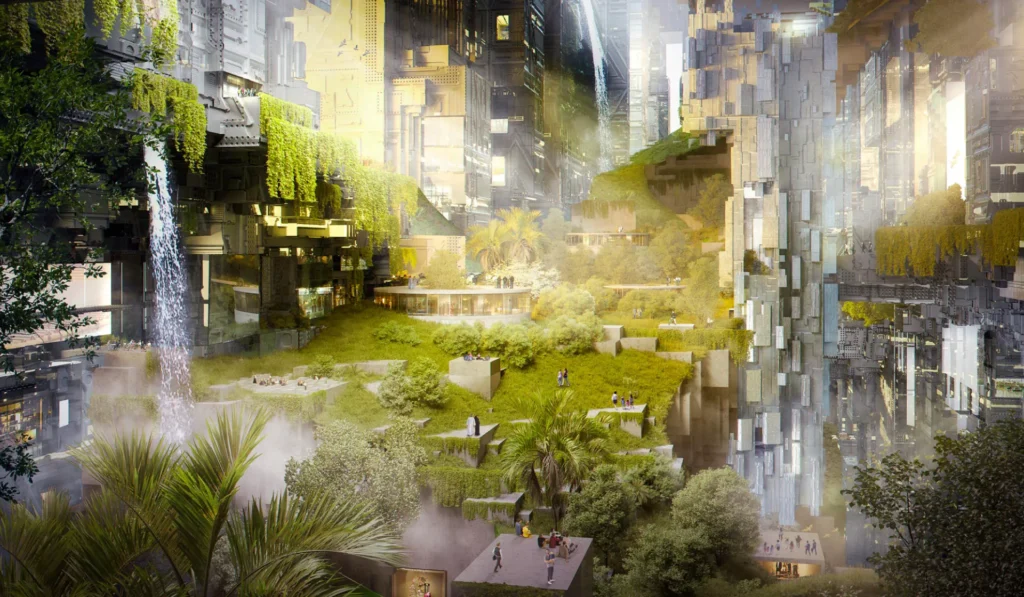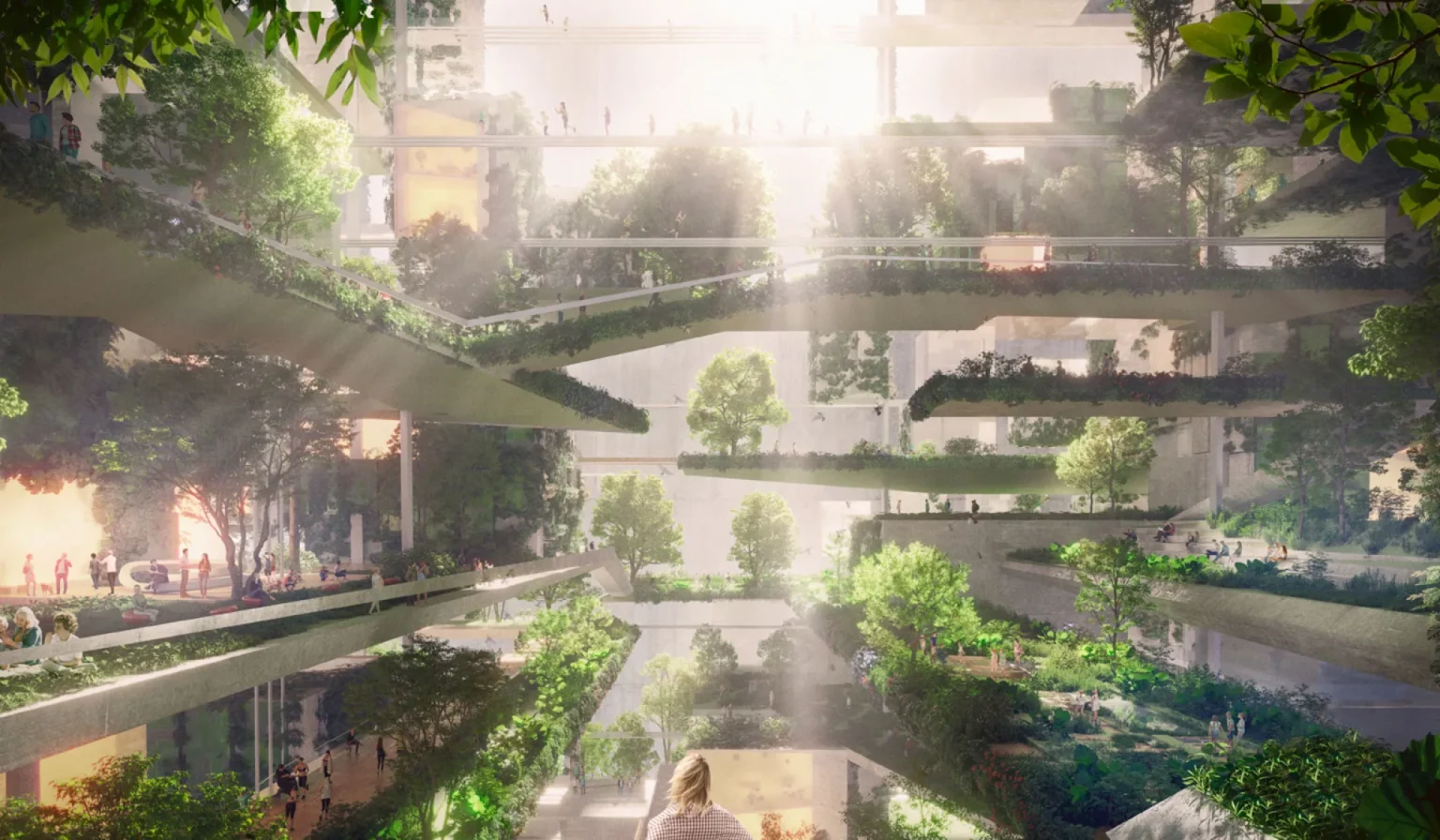Introduction
In the heart of the Saudi Arabian desert, a monumental project is taking shape—NEOM, a $1 trillion megacity that aspires to redefine urban living. Central to this vision is “The Line”, a linear city stretching 170 kilometers, designed to house nine million residents in a sustainable, car-free environment. Announced by Crown Prince Mohammed bin Salman, NEOM is a cornerstone of Saudi Arabia’s Vision 2030, aiming to diversify the economy beyond oil dependence and position the kingdom as a leader in futuristic urban development.
The Vision of ‘The Line’
“The Line” is conceived as a vertical city, 500 meters tall and 200 meters wide, encased in mirrored facades that blend seamlessly with the natural landscape. Its design eliminates the need for cars and streets, with all essential services—schools, medical facilities, leisure activities—accessible within a five-minute walk. High-speed transit systems are planned to ensure that no journey exceeds 20 minutes, promoting efficiency and sustainability. The city aims to operate on 100% clean energy, preserving 95% of NEOM’s natural environment.

Designed to be a beacon of technological innovation, “The Line” is expected to integrate artificial intelligence, smart infrastructure, and robotic systems to automate various aspects of daily life. The city will prioritize renewable energy sources such as solar and wind power, ensuring a sustainable and eco-friendly urban environment. Saudi authorities claim that NEOM will revolutionize urban planning by setting a new standard for smart cities worldwide.
Progress and Developments
Construction of “The Line” commenced in the first quarter of 2021. The initial phase, known as the Hidden Marina, is a 2.4-kilometer section designed to accommodate 300,000 residents. This phase features 80,000 apartments, 9,000 hotel rooms, retail spaces, and recreational facilities, including a synthetic ski resort and a stadium planned for the 2034 World Cup. The project’s ambition is to create a self-sustaining urban environment that leverages artificial intelligence and cutting-edge technologies to enhance the quality of life.
The Saudi government has allocated substantial financial resources to NEOM, with the Public Investment Fund (PIF) serving as its primary financier. The project’s first phase is expected to be completed by 2030, though long-term plans extend into the coming decades. To attract investors, authorities have promised a favorable business environment, tax incentives, and regulatory frameworks that support technological innovation.
Challenges and Criticisms
Despite its ambitious goals, NEOM has encountered significant challenges and criticisms:
- Financial Overruns: Initial cost estimates have escalated dramatically, with projections reaching up to $8.8 trillion, raising concerns about the project’s economic viability. Critics question whether Saudi Arabia can sustain such an expensive venture without burdening its national budget.
- Human Rights Issues: Reports indicate that thousands of workers have faced harsh conditions during construction, with allegations of labor rights violations. Critics argue that the rapid pace of development has come at the expense of worker safety and well-being.
- Environmental Impact: While NEOM aims to preserve 95% of the surrounding natural landscape, environmentalists question the ecological footprint of constructing such a massive structure in a delicate desert ecosystem. Some experts fear that disrupting the land on such a scale could lead to unforeseen environmental consequences, including water scarcity and habitat destruction.
- Technological Feasibility: Urban planners debate the practicality of a linear city, citing potential issues with social isolation, over-reliance on technology, and the challenges of creating a cohesive community in such an unprecedented format. Questions also remain about whether high-speed transportation systems can efficiently support the city’s mobility needs as envisioned.
- Cultural and Social Integration: While NEOM is designed to attract global talent, integrating diverse cultures into a single, high-tech urban environment poses challenges. The project’s futuristic nature may struggle to resonate with local traditions and societal norms, raising concerns about its acceptance among Saudi citizens.
Official Responses
Saudi officials acknowledge the project’s complexity and long-term nature. Finance Minister Mohammed Al-Jadaan described NEOM as a “50-plus-year plan,” emphasizing that immediate returns should not be expected. This perspective aligns with the kingdom’s broader strategy to diversify its economy and reduce dependence on oil revenues. Officials remain optimistic that, despite challenges, NEOM will establish Saudi Arabia as a leader in sustainable urban development and attract global investment.
NEOM’s leadership has assured that the city will be built in phases, allowing time to adapt and refine strategies based on technological advancements and economic trends. They argue that the project’s long-term benefits outweigh its current challenges and that innovation always comes with risk.
Global Perspectives
International reactions to NEOM and “The Line” are mixed. Supporters hail it as a bold step toward sustainable urbanization and a model for future cities. They believe that the project could serve as a blueprint for addressing issues such as urban congestion, pollution, and inefficient transportation networks. If successful, NEOM could inspire similar projects in other parts of the world struggling with rapid urbanization.
Critics, however, view it as an extravagant endeavor fraught with ethical, environmental, and economic pitfalls. Some urban planning experts argue that focusing on existing cities and improving their infrastructure would be a more practical approach to sustainability rather than constructing an entirely new city from scratch. Others believe that the project’s futuristic ambitions are unrealistic and will eventually lead to cost-cutting compromises that diminish its original vision.
The Road Ahead
Despite the controversies, construction continues, and Saudi Arabia remains committed to seeing NEOM through to completion. The next decade will be crucial in determining whether “The Line” can live up to its promises or if it will become a cautionary tale in urban planning history. The success of NEOM will depend on how effectively it manages its financial resources, addresses environmental concerns, and ensures ethical labor practices.
The world will be watching closely as Saudi Arabia attempts to transform a barren desert into a thriving metropolis. If NEOM succeeds, it could revolutionize urban living and set a new standard for futuristic cities. However, if it fails, it may serve as a reminder of the challenges of balancing ambition with feasibility.
Conclusion
NEOM’s “The Line” represents one of the most ambitious urban development projects in modern history. Its vision of a sustainable, technologically advanced city challenges traditional notions of urban planning. However, the myriad challenges it faces—from financial sustainability to human rights concerns—underscore the complexities inherent in such a grand undertaking. As construction progresses, the world watches closely, eager to see whether this futuristic vision will materialize into a functional, livable reality or serve as a cautionary tale for future endeavors.



